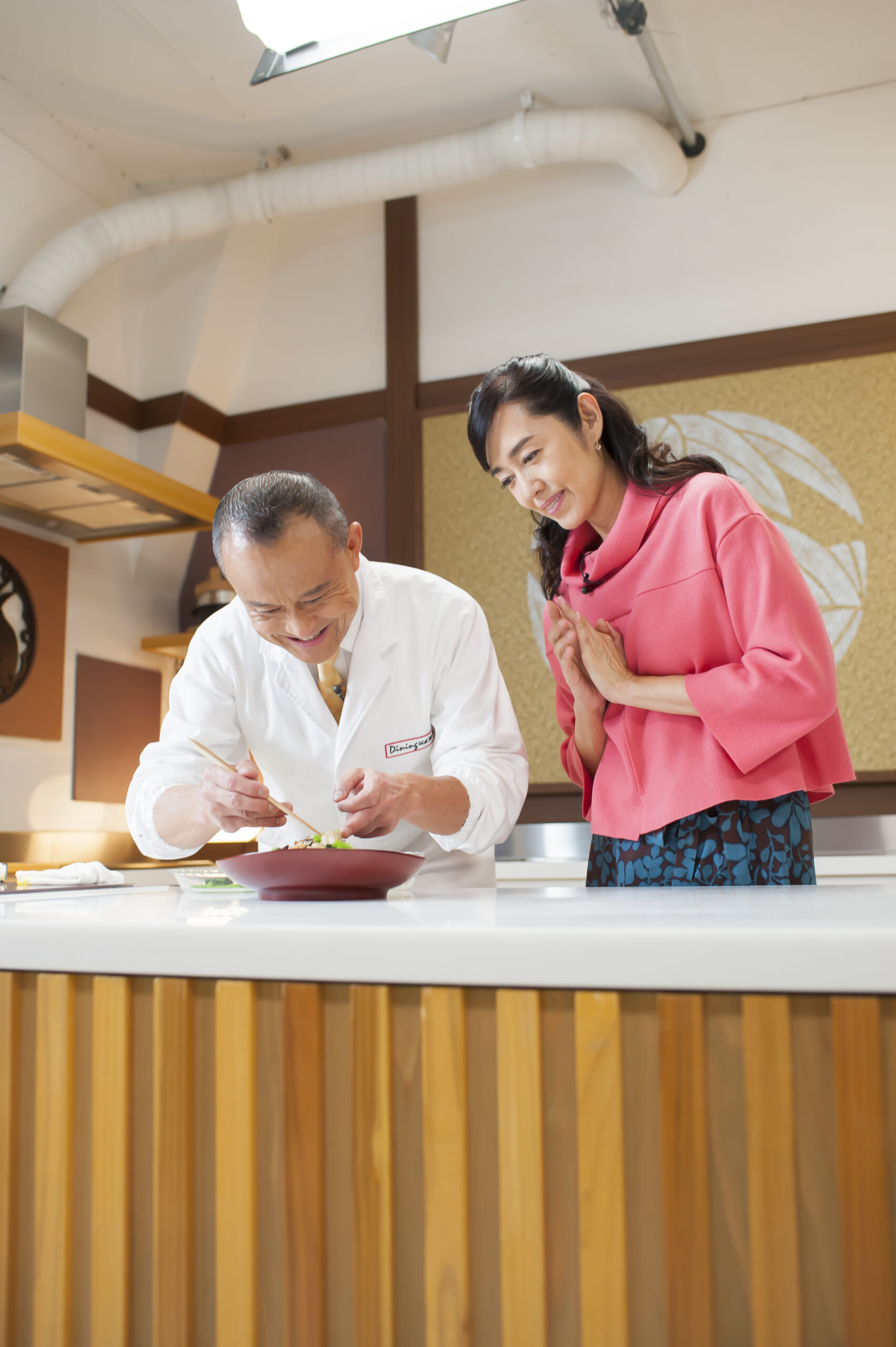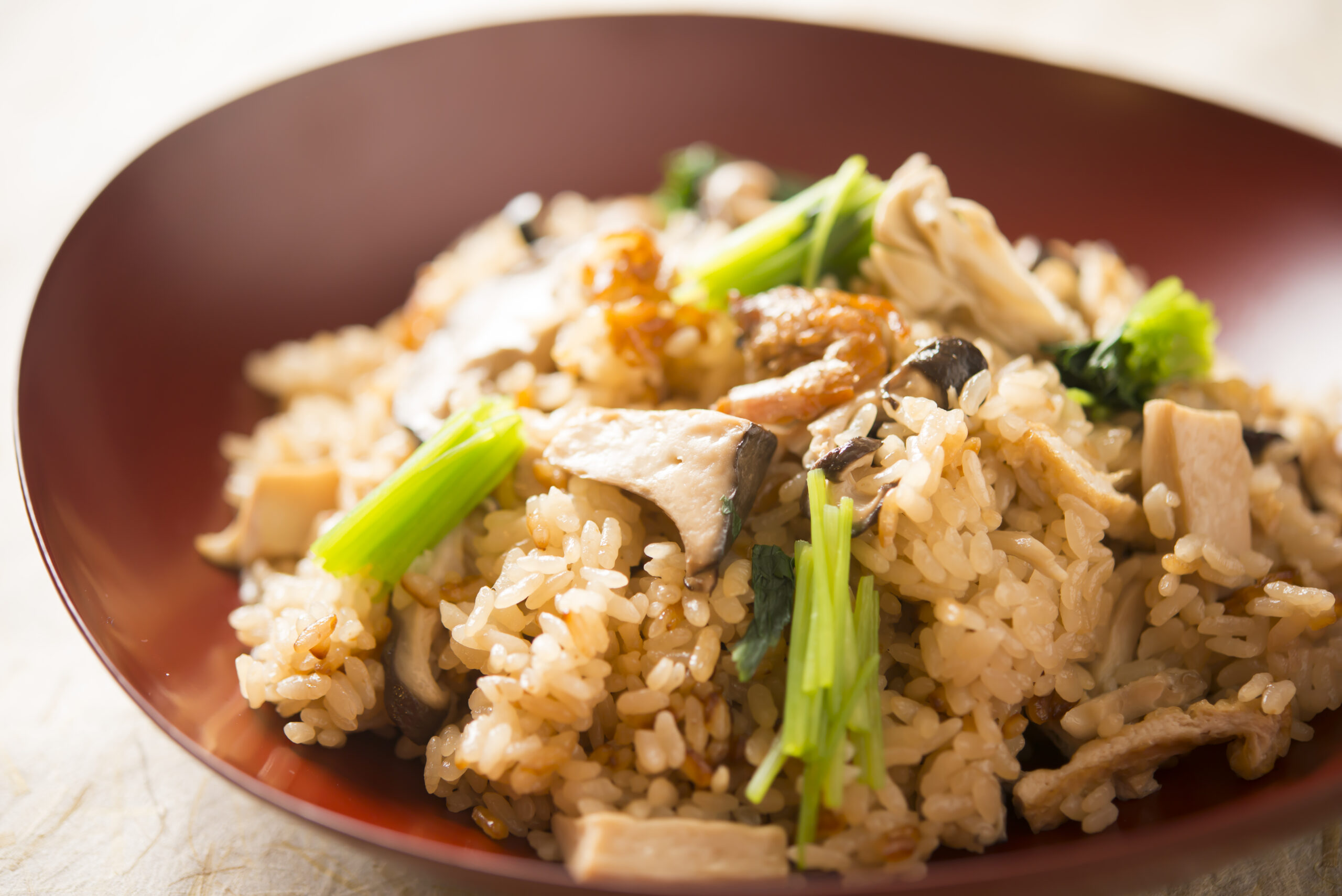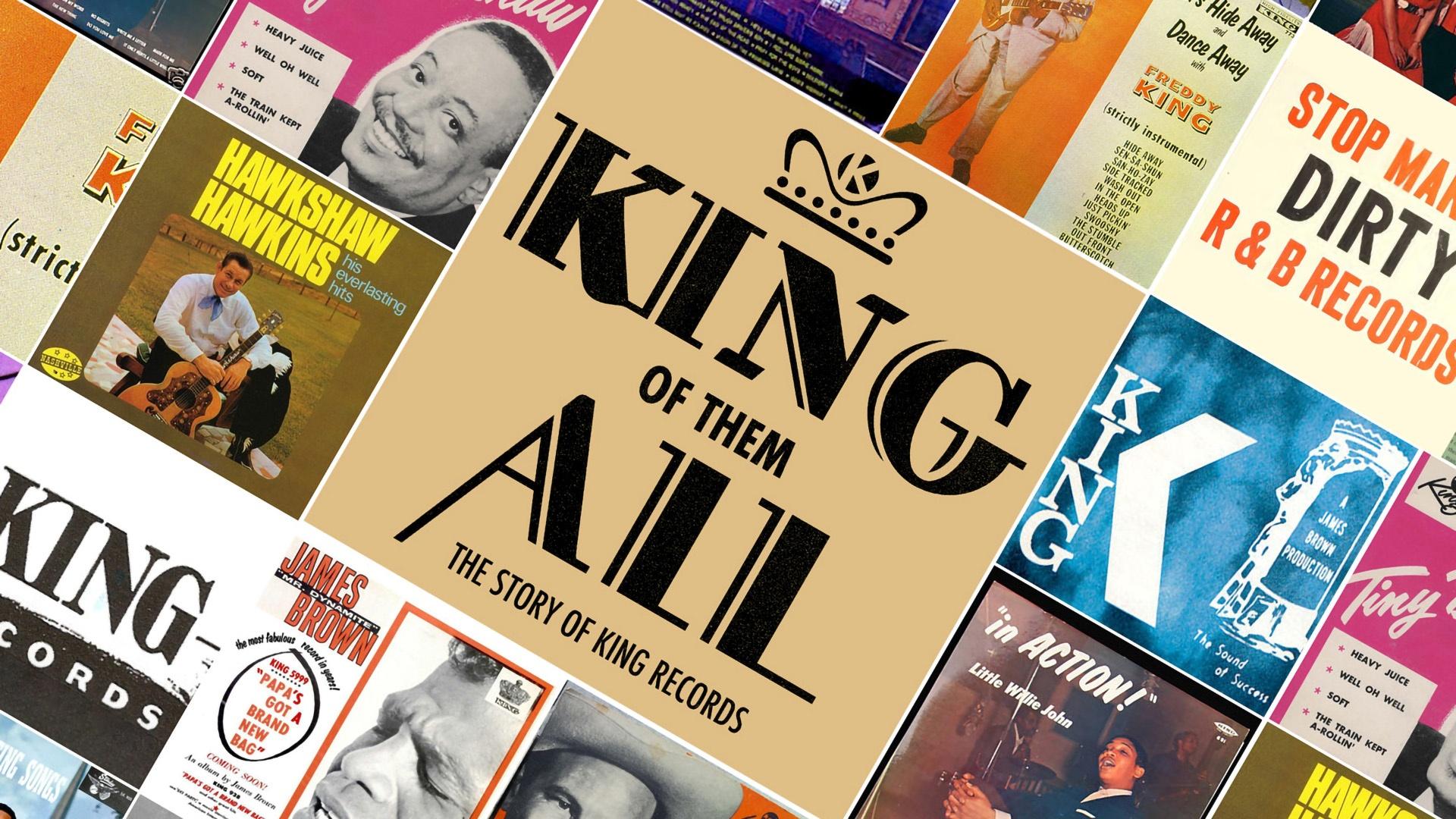For the many people who haven’t been able to travel, “Dining with the Chef” on Create has been a way to escape to another place as we watch Chef Tatsuo Saito and co-host Yu Hayami cook traditional Japanese dishes within half an hour. KLCS speaks with Yu, who is from Japan but grew up in Hawaii, about the show, how she went from being a Japanese pop singer to hosting a cooking show seen in America, what her favorite dish is and what she likes to do when she visits Los Angeles.
Yu, there are two “Dining with the Chef” shows, one with you and Chef Saito and the other with Patrick Harlan and Rika Yukimasa, whom we interviewed. What’s the theme or aim with your show with Chief Saito and how is it different?
Chef Saito has a background in very traditional Japanese cuisine and he has worked for the Japanese embassy in Paris and Washington D.C. and he has an extensive background. So when I came into the show, when “Dining with the Chef” was in its second year, they wanted to convey Japanese traditional cuisine to the viewers and hoped to convey the Japanese culture and the art of Japanese food along with some skills and tips that people at home can understand and make use of. In comparison, I think Rika’s cuisine is more Japanese home cooking, so you’ll notice when you look at her recipes, which I love, she uses fish sauce, which is not a Japanese condiment, where Chef Saito sticks to the traditional Japanese ingredients.
A lot of the dishes have the same simple ingredients.
That’s true. Japanese cooking has soy sauce, sugar, mirin, and of course dashi and salt.
I love your reaction to Chef Saito’s dishes each time and how you describe for us that the texture is crunchy, for example, or how something is balanced with something else. Is that hard to try to describe it to the viewer, because you always do it really well?
Thank you so much. I think with any type of food, texture as well as taste is so important and I love Chef Saito because watching him up close, he’s so detailed. I’ve been on the show for seven, eight years now and I can never recreate what he creates at home (laughs) as he does because he’s a perfectionist. He makes it comical and fun, that I think the viewers enjoy watching it, but what he’s actually doing behind the scenes and in front of the camera is quite detailed. And he always makes sure there are the five tastes, which includes bitter, sweet savory. And he always makes sure there is some kind of interesting texture to the food. If you have boiled spinach with sesame sauce, they’re both soft, but he’ll add a little bit of sprinkles of sesame seeds to it, so you have a bit of texture to it. The way he plans his menu for each episode, I’m just quite in awe.
You don’t plan the menu, so you don’t ever worry about running out of dishes?
The menu planning is done mostly by our producer and Chef Saito, but I do put in requests, “I want to know how to make rolled cabbage.” And he’ll look at me like, “That’s not traditional Japanese.” But he’ll do it (laughs), he’ll plan it because he wants to know what the average home cooker like myself is interested in.
So do you think your role as the host is as the home cook next to him?
Yes definitely. I think there always has to be someone saying, “How do you do that?” when it looks so simple. I don’t know if you’ve seen an episode where he grinds sesame seeds into a huge Japanese traditional bowl using that stick and he makes it look so easy. So I’ve tried it a few times over a number of years. It’s really difficult! He goes, “No, you’re supposed to put your hands this way.” I’m like, “Isn’t the outcome the same?” He hates it when I say that, but it’s ok because I’m sure the viewer is probably thinking similarly.
You also do some shows on your own where you travel around Japan and try dishes like the old traditional dishes that are displayed beautifully on the table. Do you prefer those shows where it showcases more of Japan to the rest of the world?
I do interview the chefs from around that region. I love getting feedback for “Cook Around Japan” because I think they get to see a part of Japan that they’ve never visited and as compared to what we do in the studio that’s really concentrated on how to make the food, how to prepare it. For instance, the last location we went to was in Nagano prefecture, they showcased a chef who uses natural spring water. Every morning he drives two hours to get spring water from the mountain. He made rice, but this rice was amazing. So you realize water is a very important ingredient in cooking.
How different does rice taste with spring water?
I think it’s all about the dashi. The natural spring water that he uses in Nagano prefecture is very much like the one in Kyoto, which is very soft water, so when he makes the dashi broth with the bonito and the seaweed, the dashi comes out very mellow. It has a lot of umami in it. But of course, rice is just made out of water, but after that he adds a little bit of dashi and you can try it different ways. When I interviewed him, it’s not just the water, of course the rice that he uses is made in that region and that comes back to what type of water they use. And it’s just amazing how a lot of chefs gauge their food on Michelin star and this and that, but I realize travelling around Japan that chefs that we interviewed really care and have a deep affection and love for the ingredients that comes from their region.
What was your path to being on a cooking show on TV?
I spoke English (laughs). I know you can’t really see the process of it, but when the scripts are made a lot of them are translated by non-cooks, so you get the metrics wrong, or there’ll be a bit of an English mishap, so I think that’s where I come in. But I’m a singer and actress here in Japan and somehow throughout my career, I’ve always been fortunate to host a cooking show, so this is not my first cooking show, although it is my first cooking show that I’ve co-hosted in English. I started back in the ‘80s; I was a pop singer. It’ll be my 40th year next year and I still do concerts, but in Japan, in the U.S. too, like Gwyneth Paltrow; she’s an actress but does some cooking things. In Japan it’s been like that historically. I had a cooking show in the ‘90s. Back then I didn’t know how to cook so it was more comical that I would try to bread something and it wouldn’t turn out right, or something would explode, but they always have to add a fun part of it because I’m not a professional chef. I think the producer saw I could speak English and she wanted someone who liked cooking. If you read any of my interviews that’s all I talk about. I talk about food, I talk about food and I talk about food. (laughs)
Your English is very good.
I was born in Japan; I grew up Hawaii. I was reading someone’s review saying, I love how she says, “Teriyaki like we do!” I was scouted as a model in Hawaii and when I came back to Japan, they asked me if I wanted to audition to be a singer. And my father was a jazz singer, so I’ve always loved singing. So I said, “Ok.” My career started when I was 15.
Do you have a favorite dish to cook?
I love pork ginger. Thin slices of pork marinated in ginger and soy sauce and then you cook it in the frying pan, you serve it with shredded cabbage and white rice. I love it because it’s super healthy. A lot of people say Japanese food contains a lot of salt, but when you see it in the long run, because we eat little bits and pieces of this and that, I think there’s always a good balance of protein [and] vegetables.
In Japan there’s a lot of deep frying, yet people are pretty slim.
Right, yeah, that’s true.
And you do a lot of eating for the show, what do you think is the secret to staying slim?
I really think it’s how much you consume. Chef Saito always says, “Look at the plate, make sure there are five colors. I find that, because my husband is American and when we visit his family in America, I love fried foods, but a lot of the colors on the dish [are] brown. It’s one color. So I think it’s a balance. This past year because of Covid, people did a lot of takeout and I think the biggest craze was fried chicken. Bit it’s not the fried chicken you’re used to seeing in the U.S. It’s the karaage, where you bread with potato starch, not the flour. And I don’t think we eat a whole bunch. You have fried food, you have a little bit of it and then you have other things to go with it.
What’s the favorite part of your job?
I love working with Chef Saito, he is so funny.
Does he speak English at all?
He actually speaks English quite well, because he worked in Washington D.C. for a while, but it’s the same with me, when you’re thinking in Japanese and you have to cross over to English, of course it’s not in his daily routine, it takes a little more time. But when we use to shoot on location abroad, he’s fine, he can order at the restaurant. I don’t think he speaks as well as Rika does, she’s quite fluent. I love working with Chef Saito, I love our staff; everyone is great. I feel like for the longest time Japan has been the one to be influenced by Western culture and I feel like finally, they’re interested in our culture. And through food, which is one of my favorite things, we’re able to convey our culture that way. And who doesn’t like to eat?
Everyone’s had a Julia Child story or that she’s influenced them. Do you have Julia Child story or feel she’s influenced you?
Not someone famous like Julia Child. My grandmother was born and raised in Europe, but she’s Japanese, so our family was always a bit international that way. When my grandmother cooked, she would make Western meals; her lasagna was amazing. And when my mother cooked, she would make braised burdock and carrots, which was amazing as well. I think my Julia Child were both of them and having two daughters now, now that they’re going off to college, I’m writing a cookbook, not to be published, just for them to take along so they can use in their dormitories. You realize food is something you take for granted, “Oh, yeah, I’m hungry, mom will cook for me,” and I remember when, both are deceased, my grandmother and mother, when I was really tired, I wanted that certain tomato pasta taste that my grandmother made so I went to restaurants. This was in my 20s. I couldn’t find it, so I thought, “I’m going to make it on my own.” And you realize your palate is the biggest asset that you receive from your mother and grandmother. And of course I do have a lot of cookbooks, but I realize in the end, it’s really what you receive at home.
Why wouldn’t you make the cookbook public, that’s a good idea?
Yeah, if someone’s going to publish it, I would love it. (laughs) There’s so many cookbooks out there.
Do you get feedback from Los Angeles viewers about the show?
I do. I have so many friends. I guess friends don’t really count. I have a blog, I think my company has a Facebook and I do get a lot of feedback from people around the world and they just love the show. I remember one foreign man who lives in Japan came up to me at the supermarket, he goes, “I know you.” I said, “I’m sorry I don’t think we’ve ever met.” “Oh, you’re the lady on ‘Dining with the Chef!’” He said, “I love that show.” We stood there for half an hour and he told me how much he loved it and he said, “A lot of the dishes I can’t make because Chef Saito is so perfect, but I just love watching it.” It’s sort of like in any situation where you watch a professional do something so beautifully. He loves it, so happy.
Your show really is the professional chef version and Rika’s is the home cook version. His recipes are hard to replicate.
I remember the first year I was on, the second episode, he made this fancy fish that you would only find in these fancy high end restaurants in Japan. So he fileted the fish with the bone, he deep fried it so it looked like a boat. And I stood there thinking, “Who’s going to make that?” (laughs) It’s just beautiful to watch and see and if you’re ever lucky to come across it, you’ll know what went into it to make that.
What’s the most frequent question you get from viewers? And what is your answer to that question?
The question I get is, “How is it working with Chef Saito?” (laughs) I receive so many on my Instagram post, “How is it?” And also, before COVID, when people plan on traveling to Tokyo, they ask where Chef Saito’s restaurant is, because I think in America, if you’re a celebrity on TV you have a restaurant. But Chef Saito doesn’t, but does have a cooking school. I did suggest that once, “We should have a pop-up restaurant.” I have a license in wine, like a sommelier. “I’ll choose the wines and you can do your Japanese food.” And our producer said, “Yu-san, wine isn’t Japanese. (laughs) Maybe you can pair with sake.” It’s all up to chef Saito if we can put him in the mood. (laughs)
What did he say?
He said, “That sounds like a good idea!” And then he thought about it and he goes, “That’s a lot of work though.” (laughs) It is, because he’s really busy, he has many other shows he guest stars in and he has his cooking school and before COVID he travelled around Japan giving lectures about cooking, the philosophy of cooking, the art of cooking.
Do ever just pinch yourself that you get to do this for a living?
I do! I actually have to work hard for other things, but on the days I get to go to the “Dining with the Chef” studio, I really look forward to it. I love it; it’s great. It’s like eight years of free cooking lessons.
When you’re in L.A., do you have any favorite places to dine at, since you have friends here?
I do and part of my family is in San Diego. I haven’t been there for a long time. One thing we don’t have in Japan, we do, but not too many, is Mexican restaurants. So when I’m in L.A. I love going to Mexican restaurants.
Is there anything you want to add about Dining with the Chef?
I just hope that people, of course in this time of COVID, we can’t travel and I know that Japan is loved by so many people. I hope they can get a glimpse of Japan and Japanese culture and I hope that we can fill their harts and stomachs with Chef Saito’s food.
Watch Dining with the Chef , Mondays on KLCS’ createTV.
You can keep up with Yu Hayami on her social media via Instagram (https://www.instagram.com/yuyuhayami/).























